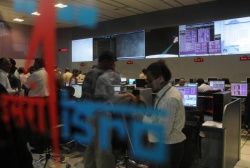Indian Space Research Organisation Chairman K. Radhakrishnan does not believe the November 5 ‘desi’ Mars Orbiter Mission (MOM) will fuel a space race with China which has not yet attempted such a venture to the red planet.
Mr. Radhakrishnan, Secretary in the Department of Space and Chairman of Space Commission, said each country — whether it’s India, the US, Russia or China — had their own priorities.
“There is no race with anybody. If you look at anybody, they have their own direction. So, I don’t find a place for race with somebody. But I would say we are always on race with ourselves to excel in areas that we have chalked out for ourselves,” he told PTI here in an interview.
The MOM would be launched onboard PSLV C25 on November 5 from the Satish Dhawan Space Centre in the spaceport of Sriharikota.
Bangalore-headquartered ISRO, he said, is focused on space application, communication, remote sensing, navigation and space sciences and building satellites for those areas, besides indigenous launch vehicle technology.
If India succeeds in the MOM, it would be the fourth in the world, after the US, Russia and Europe to do so.
“China tried this, not exactly as a Mars mission of their own, they joined Russia and did a Probos-Grunt mission. That was in 2011 which had a problem; it did not leave the earth orbit. So, they (China) have not attempted as of now. But India will be the fourth country if you are able to succeed.”
“That we can say in September 2014 (when the MOM spacecraft is planned to be inserted into Mars orbit). Being a complex mission of this nature, any day you advance it’s a progress,” Mr. Radhakrishnan said.
“85 per cent marks if you achieve that. But each day you will get marks. Each operation is important. We are able to estimate here itself (before leaving the earth’s orbit on November 30) what’s going to be your (the spacecraft’s) position in September 2014 (when it’s planned to be inserted into the Mars orbit),” Mr. Radhakrishnan said.
“If you are able to orbit and if you are able to conduct a few meaningful experiments, then you get scientific knowledge about Mars,” he said.
Two key scientific instruments (of the total five) on board the MOM spacecraft are methane sensor for Mars (MSM) and thermal infrared imaging spectrometer (TIS).
“Observations are focused towards presence of methane and that methane, if it’s there, is from which source? Bio-genic or geological? So, we have a TIS. Methane sensor and thermal infrared sensor together should be able to give some information on this.”
The three other instruments are: Mars exospheric neutral composition analyser (MENCA), Lyman Alpha Photometer (LAP) and Mars Colour Camera (MCC), ISRO officials said.
MENCA is a quadraple mass spectrometer capable of analysing the neutral composition in the range of 1 to 300 amu (atomic mass unit) with unit mass resolution, while LAP measures the relative abundance of deuterium and hydrogen from Lyman-alpha emission in the Martian upper atmosphere.
“Measurement of D/H (Deuterium to Hydrogen abundance ratio) allows us to understand especially the loss process of water from the planet,” an ISRO official said.
The tri-colour MCC gives images and information about the surface features and composition of Martian surface. They are useful to monitor the dynamic events and weather of Mars. MCC will also be used for probing the two satellites of Mars — Phobos and Deimos, ISRO officials said.







Comments